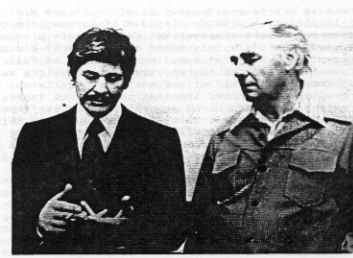|
"Old Overcast"
61st Squadron |
| 3 | 4 |
|
This particular crew was assigned to the 61st Squadron, 39th Bomb Group on Guam from July until October 1945. Ken Trow, its Airplane Commander, has many recollections of these years as well as those that followed during his Air Force career. Ken joined the RCAF a year and a day before Pearl Harbor and it was there he received his flight training and commission as a, Pilot Officer. In 1942, he was transferred in grade to the US Army Air Force and was assigned as an instructor pilot in AT-6's. At the end of October 1943, it was decided it was time for Ken to become more active in the war effort, and he was sent to Lockburne AFF in Columbus. Ohio to learn how to fly four engine aircraft. They turned out to be war-weary B-17's. By the end of December he had completed his transition training and was sent to Clovis, New Mexico to train as a pilot in the very latest in aircraft - the B-29. He and his wife, Alice, arrived in Clovis on New years Day, 1944. After a very comprehensive training period, which consisted of five hours of flying time - Trow was judged to be a qualified B-29 instructor pilot. Most of the crew training during this time was done in B-17's. There just weren't enough B-29's available yet.
At this stage, the B-29 was not a tried and true aircraft. It was still very much in the developmental process and crews were actually being used as much for the purpose of testing them as for training. It was difficult to catch up in the building of needed B-29's because we were losing them nearly as fast as new ones arrived. Ken remembers two occasions when he was lined up waiting for take off. Both times, the planes ahead of him crashed. Also, there were many times he returned to the field on three engines, sometimes even two. He never failed to kiss his wife when leaving the house to go flying. The way things were going, it could be his last flight. In the spring of 1945, it was determined that Trow had done enough instructing and it was time for him to become more closely involved in the war. The director of training at Clovis, who was a close friend, received a call for a weather reconnaissance crew for overseas duty. He thought this might be a good deal so he named Ken for the job. The bombardier was replaced with a weather observer, and the crew did some additional training. A great deal of time was spent climbing to 30, 000 feet and dropping out a radiosonde transmitter and as it descended by parachute to the ground, the radio operator would record the transmissions. A radiosonde that was normally sent up by balloon from the ground, in this case the procedure was reversed. The weatherman assigned to A/C Trow had not had any formal gunnery training and a nose gunner was required. The man assigned to this position was a young fellow named Charles Buchinski, which at the time was not significant. It wasn't until after the war that the name again came into view - this time on the movie screen. He later changed Buchinski to Bronson! When it came time to depart for overseas, the crew moved up to Wichita to await their B-29. As soon as it arrived, they were on their way to Mather Field, Sacramento, CA. After a final briefing there, they headed for North Field, Guam by way of Hawaii and Kwajaleln. When Ken reported to the Commanding Officer, he immediately recognized him as having been in a class of students he had instructed at Dothan, Alabama! It's truly a small world. Ken recalls one take off very vividly. It was dark and rainy and visibility was poor. Instead of turning the generator switches on, flight engineer Kit Carson made a major goof and turned them off! This meant that the only electric the aircraft had was that supplied by the "Putt-Putt." When the plane became air bound, and the gear up switch was hit, all of the lights went out! Even though Sgt. Carson immediately realized his error, the instrument panel lights were fluorescent and it required several seconds for them to restart. The 500 feet gained as they passed over the cliff gave Trow a short breathing spell. It was at that point, that nose gunner Buchinsky, who had been sitting on the aisle stand, reacted. He quickly produced a flashlight, which allowed the pilot to see the panel instead of flying blind.
Weather Observation Crew Main Page 61st Squadron Crew Index |
